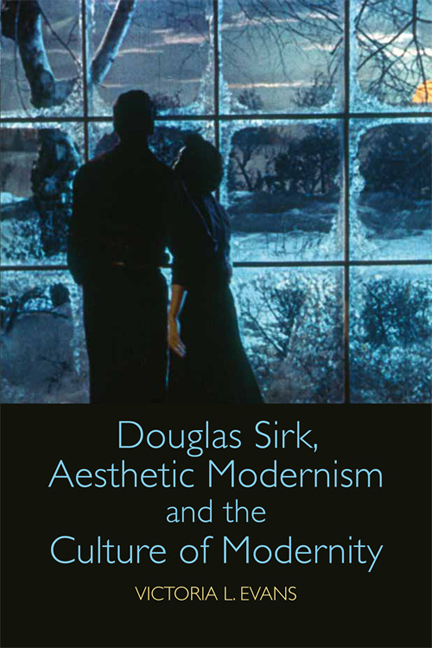Book contents
- Frontmatter
- Contents
- List of Figures
- Acknowledgements
- Introduction
- PART ONE SIRK AND THE VISUAL ARTS
- PART TWO THE SHOCK OF THE NEW: TRACES OF MODERNITY
- PART THREE TWO ARCHITECTURAL CASE STUDIES
- 5 Final Chord and ‘Die Neue Welt’: The Mise-en-scène of Aufbruch
- 6 Back to the Future: Modernist Architecture and All That Heaven Allows
- Bibliography
- Index
6 - Back to the Future: Modernist Architecture and All That Heaven Allows
from PART THREE - TWO ARCHITECTURAL CASE STUDIES
Published online by Cambridge University Press: 20 December 2017
- Frontmatter
- Contents
- List of Figures
- Acknowledgements
- Introduction
- PART ONE SIRK AND THE VISUAL ARTS
- PART TWO THE SHOCK OF THE NEW: TRACES OF MODERNITY
- PART THREE TWO ARCHITECTURAL CASE STUDIES
- 5 Final Chord and ‘Die Neue Welt’: The Mise-en-scène of Aufbruch
- 6 Back to the Future: Modernist Architecture and All That Heaven Allows
- Bibliography
- Index
Summary
In a prominent two-page pictorial spread that was published in a March 1948 issue of Life magazine, an anonymous writer credits a New York architect with transforming an ‘old-fashioned dwelling’ into a ‘striking modern home’. According to the brief text that accompanied this rather dramatic set of photographs (which included a full-page view of the most transparent elevation lit up at night), a ‘moldering’ Connecticut farmhouse has been made ‘new’ by the installation of an enormous glass window in one façade and by leaving the partially demolished interior relatively open-plan. The reconstruction of the Old Mill in Douglas Sirk's 1955 melodrama All That Heaven Allows produces a similar effect, since Ron Kirby will eventually build both of these elements of the ideal contemporary home into his renovated dwelling. In what constitutes the film's most important domestic setting, since it makes visually manifest the tree farmer's love for Carey Scott, he will combine aspects of two competing Modernist idioms (according to Elizabeth Gordon, the current editor of House Beautiful magazine). At first, the Old Mill's rough timber and masonry walls evoke the ‘home-grown variety’ that Gordon associates with Frank Lloyd Wright, who was the major source of the mid-century American preoccupation with ‘natural’ finishes and irregular shapes. By the end of the narrative, however, these raw ‘organic’ surfaces will have disappeared behind a whitewashed patina that was more typical of the Machine Age dwellings of the 1920s (what Gordon dubs the International Style after Philip Johnson and Henry-Russell Hitchcock's well-known catalogue).
In other words, this pivotal building's hybrid architectural language reveals an underlying connection that House Beautiful's anti-International Style campaign had deliberately obscured: American and European Modernism each contained both ‘organic’ and ‘mechanistic’ tendencies, despite their very disparate appearances. For example, in an early public lecture Frank Lloyd Wright praised the machine's capacity to liberate the worker from repetitive drudgery, and many of his most inventive designs could not have been executed without the use of industrial materials such as high tensile steel.
- Type
- Chapter
- Information
- Douglas Sirk, Aesthetic Modernism and the Culture of Modernity , pp. 147 - 178Publisher: Edinburgh University PressPrint publication year: 2017



